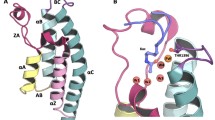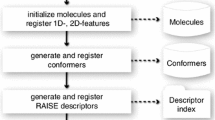Abstract
SAMPL3 fragment based virtual screening challenge provides a valuable opportunity for researchers to test their programs, methods and screening protocols in a blind testing environment. We participated in SAMPL3 challenge and evaluated our virtual fragment screening protocol, which involves RosettaLigand as the core component by screening a 500 fragments Maybridge library against bovine pancreatic trypsin. Our study reaffirmed that the real test for any virtual screening approach would be in a blind testing environment. The analyses presented in this paper also showed that virtual screening performance can be improved, if a set of known active compounds is available and parameters and methods that yield better enrichment are selected. Our study also highlighted that to achieve accurate orientation and conformation of ligands within a binding site, selecting an appropriate method to calculate partial charges is important. Another finding is that using multiple receptor ensembles in docking does not always yield better enrichment than individual receptors. On the basis of our results and retrospective analyses from SAMPL3 fragment screening challenge we anticipate that chances of success in a fragment screening process could be increased significantly with careful selection of receptor structures, protein flexibility, sufficient conformational sampling within binding pocket and accurate assignment of ligand and protein partial charges.










Similar content being viewed by others
References
Shuker SB, Hajduk PJ, Meadows RP, Fesik SW (1996) Discovering high-affinity ligands for proteins: SAR by NMR. Science 274(5292):1531–1534
Hopkins AL, Groom CR, Alex A (2004) Ligand efficiency: a useful metric for lead selection. Drug Discov Today 9(10):430–431. doi:10.1016/S1359-6446(04)03069-7
Artis DR, Lin JJ, Zhang C, Wang W, Mehra U, Perreault M, Erbe D, Krupka HI, England BP, Arnold J, Plotnikov AN, Marimuthu A, Nguyen H, Will S, Signaevsky M, Kral J, Cantwell J, Settachatgull C, Yan DS, Fong D, Oh A, Shi S, Womack P, Powell B, Habets G, West BL, Zhang KY, Milburn MV, Vlasuk GP, Hirth KP, Nolop K, Bollag G, Ibrahim PN, Tobin JF (2009) Scaffold-based discovery of indeglitazar, a PPAR pan-active anti-diabetic agent. Proc Natl Acad Sci USA 106(1):262–267. doi:10.1073/pnas.0811325106
Card GL, Blasdel L, England BP, Zhang C, Suzuki Y, Gillette S, Fong D, Ibrahim PN, Artis DR, Bollag G, Milburn MV, Kim SH, Schlessinger J, Zhang KY (2005) A family of phosphodiesterase inhibitors discovered by cocrystallography and scaffold-based drug design. Nat Biotechnol 23(2):201–207. doi:10.1038/nbt1059
Tsai J, Lee JT, Wang W, Zhang J, Cho H, Mamo S, Bremer R, Gillette S, Kong J, Haass NK, Sproesser K, Li L, Smalley KS, Fong D, Zhu YL, Marimuthu A, Nguyen H, Lam B, Liu J, Cheung I, Rice J, Suzuki Y, Luu C, Settachatgul C, Shellooe R, Cantwell J, Kim SH, Schlessinger J, Zhang KY, West BL, Powell B, Habets G, Zhang C, Ibrahim PN, Hirth P, Artis DR, Herlyn M, Bollag G (2008) Discovery of a selective inhibitor of oncogenic B-Raf kinase with potent antimelanoma activity. Proc Natl Acad Sci USA 105(8):3041–3046. doi:10.1073/pnas.0711741105
Congreve M, Chessari G, Tisi D, Woodhead AJ (2008) Recent developments in fragment-based drug discovery. J Med Chem 51(13):3661–3680. doi:10.1021/jm8000373
Hajduk PJ, Greer J (2007) A decade of fragment-based drug design: strategic advances and lessons learned. Nat Rev Drug Discov 6(3):211–219. doi:10.1038/nrd2220
Murray CW, Rees DC (2009) The rise of fragment-based drug discovery. Nat Chem 1(3):187–192. doi:10.1038/nchem.217
de Kloe GE, Bailey D, Leurs R, de Esch IJ (2009) Transforming fragments into candidates: small becomes big in medicinal chemistry. Drug Discov Today 14(13–14):630–646. doi:10.1016/j.drudis.2009.03.009
Bollag G, Hirth P, Tsai J, Zhang J, Ibrahim PN, Cho H, Spevak W, Zhang C, Zhang Y, Habets G, Burton EA, Wong B, Tsang G, West BL, Powell B, Shellooe R, Marimuthu A, Nguyen H, Zhang KY, Artis DR, Schlessinger J, Su F, Higgins B, Iyer R, D’Andrea K, Koehler A, Stumm M, Lin PS, Lee RJ, Grippo J, Puzanov I, Kim KB, Ribas A, McArthur GA, Sosman JA, Chapman PB, Flaherty KT, Xu X, Nathanson KL, Nolop K (2010) Clinical efficacy of a RAF inhibitor needs broad target blockade in BRAF-mutant melanoma. Nature 467(7315):596–599. doi:10.1038/nature09454
Zartler ER, Mo H (2007) Practical aspects of NMR-based fragment discovery. Curr Top Med Chem 7(16):1592–1599
Hartshorn MJ, Murray CW, Cleasby A, Frederickson M, Tickle IJ, Jhoti H (2005) Fragment-based lead discovery using X-ray crystallography. J Med Chem 48(2):403–413. doi:10.1021/jm0495778
Neumann T, Junker HD, Schmidt K, Sekul R (2007) SPR-based fragment screening: advantages and applications. Curr Top Med Chem 7(16):1630–1642
Kolb P, Ferreira RS, Irwin JJ, Shoichet BK (2009) Docking and chemoinformatic screens for new ligands and targets. Curr Opin Biotechnol 20(4):429–436. doi:10.1016/j.copbio.2009.08.003
Murray CW, Callaghan O, Chessari G, Cleasby A, Congreve M, Frederickson M, Hartshorn MJ, McMenamin R, Patel S, Wallis N (2007) Application of fragment screening by X-ray crystallography to beta-secretase. J Med Chem 50(6):1116–1123. doi:10.1021/jm0611962
Huang JW, Zhang Z, Wu B, Cellitti JF, Zhang X, Dahl R, Shiau CW, Welsh K, Emdadi A, Stebbins JL, Reed JC, Pellecchia M (2008) Fragment-based design of small molecule X-linked inhibitor of apoptosis protein inhibitors. J Med Chem 51(22):7111–7118. doi:10.1021/jm8006992
Chen Y, Shoichet BK (2009) Molecular docking and ligand specificity in fragment-based inhibitor discovery. Nat Chem Biol 5(5):358–364. doi:10.1038/nchembio.155
Teotico DG, Babaoglu K, Rocklin GJ, Ferreira RS, Giannetti AM, Shoichet BK (2009) Docking for fragment inhibitors of AmpC beta-lactamase. Proc Natl Acad Sci USA 106(18):7455–7460. doi:10.1073/pnas.0813029106
Hubbard RE, Chen I, Davis B (2007) Informatics and modeling challenges in fragment-based drug discovery. Curr Opin Drug Discov Dev 10(3):289–297
Babaoglu K, Shoichet BK (2006) Deconstructing fragment-based inhibitor discovery. Nat Chem Biol 2(12):720–723. doi:10.1038/nchembio831
May A, Zacharias M (2008) Protein-ligand docking accounting for receptor side chain and global flexibility in normal modes: evaluation on kinase inhibitor cross docking. J Med Chem 51(12):3499–3506. doi:10.1021/jm800071v
Meiler J, Baker D (2006) ROSETTALIGAND: protein-small molecule docking with full side-chain flexibility. Proteins 65(3):538–548. doi:10.1002/prot.21086
Nabuurs SB, Wagener M, de Vlieg J (2007) A flexible approach to induced fit docking. J Med Chem 50(26):6507–6518. doi:10.1021/jm070593p
Anderson AC, O’Neil RH, Surti TS, Stroud RM (2001) Approaches to solving the rigid receptor problem by identifying a minimal set of flexible residues during ligand docking. Chem Biol 8(5):445–457
Totrov M, Abagyan R (2008) Flexible ligand docking to multiple receptor conformations: a practical alternative. Curr Opin Struct Biol 18(2):178–184. doi:10.1016/j.sbi.2008.01.004
Davis IW, Baker D (2009) RosettaLigand docking with full ligand and receptor flexibility. J Mol Biol 385(2):381–392. doi:10.1016/j.jmb.2008.11.010
Davis IW, Raha K, Head MS, Baker D (2009) Blind docking of pharmaceutically relevant compounds using RosettaLigand. Protein Sci 18(9):1998–2002. doi:10.1002/pro.192
Kawatkar S, Wang H, Czerminski R, Joseph-McCarthy D (2009) Virtual fragment screening: an exploration of various docking and scoring protocols for fragments using Glide. J Comput Aided Mol Des 23:527–539. doi:10.1007/s10822-009-9281-4
Sandor M, Kiss R, Keseru GM (2010) Virtual fragment docking by Glide: a validation study on 190 protein-fragment complexes. J Chem Inf Model 50(6):1165–1172. doi:10.1021/ci1000407
Skillman G, Geballe M, Nicholls A (2012) The SAMPL3 challenge. J Comput Aided Mol Des, this issue
OpenEye Scientific Software, Inc., Santa Fe, NM, USA. www.eyesopen.com
Peat TS, Newman J (2012) High throughput fragment screening-Trypsin. J Comput Aided Mol Des, this issue
Newman J, Fazio VJ, Caradoc-Davies TT, Branson K, Peat TS (2009) Practical aspects of the SAMPL challenge: providing an extensive experimental data set for the modeling community. J Biomol Screen 14(10):1245–1250. doi:10.1177/1087057109348220
Berman HM, Westbrook J, Feng Z, Gilliland G, Bhat TN, Weissig H, Shindyalov IN, Bourne PE (2000) The protein data bank. Nucleic Acids Res 28(1):235–242
Congreve M, Carr R, Murray C, Jhoti H (2003) A ‘rule of three’ for fragment-based lead discovery? Drug Discov Today 8(19):876–877
Molecular Operating Environment (MOE), version 2010.10; Chemical Computing Group Inc.: Montreal, QC, Canada, 2010
Labute P (2009) Protonate3D: assignment of ionization states and hydrogen coordinates to macromolecular structures. Proteins 75(1):187–205. doi:10.1002/prot.22234
Labute P (2010) LowModeMD—implicit low-mode velocity filtering applied to conformational search of macrocycles and protein loops. J Chem Inf Model 50(5):792–800. doi:10.1021/ci900508k
Halgren TA (1999) MMFF VI. MMFF94s option for energy minimization studies. J Comput Chem 20(7):720–729. doi:10.1002/(sici)1096-987x(199905)20:7<720::aid-jcc7>3.0.co;2-x
Marcou G, Rognan D (2007) Optimizing fragment and scaffold docking by use of molecular interaction fingerprints. J Chem Inf Model 47(1):195–207. doi:10.1021/ci600342e
Rogers DJ, Tanimoto TT (1960) A computer program for classifying plants. Science 132(3434):1115–1118. doi:10.1126/science.132.3434.1115
Wang R, Fang X, Lu Y, Wang S (2004) The PDBbind database: collection of binding affinities for protein-ligand complexes with known three-dimensional structures. J Med Chem 47(12):2977–2980. doi:10.1021/jm030580l
Wang R, Fang X, Lu Y, Yang CY, Wang S (2005) The PDBbind database: methodologies and updates. J Med Chem 48(12):4111–4119. doi:10.1021/jm048957q
Robin X, Turck N, Hainard A, Tiberti N, Lisacek F, Sanchez JC, Muller M (2011) pROC: an open-source package for R and S+ to analyze and compare ROC curves. BMC Bioinforma 12:77. doi:10.1186/1471-2105-12-77
R Development Core Team (2008) R: a language and environment for statistical computing. R Foundation for Statistical Computing, Vienna, Austria. ISBN 3-900051-07-0. http://www.R-project.org
Bottegoni G, Rocchia W, Rueda M, Abagyan R, Cavalli A (2011) Systematic exploitation of multiple receptor conformations for virtual ligand screening. PLoS One 6(5):e18845. doi:10.1371/journal.pone.0018845
Craig IR, Essex JW, Spiegel K (2010) Ensemble docking into multiple crystallographically derived protein structures: an evaluation based on the statistical analysis of enrichments. J Chem Inf Model 50(4):511–524. doi:10.1021/ci900407c
Huang SY, Zou X (2007) Ensemble docking of multiple protein structures: considering protein structural variations in molecular docking. Proteins 66(2):399–421. doi:10.1002/prot.21214
Rao S, Sanschagrin PC, Greenwood JR, Repasky MP, Sherman W, Farid R (2008) Improving database enrichment through ensemble docking. J Comput Aided Mol Des 22(9):621–627. doi:10.1007/s10822-008-9182-y
Rueda M, Bottegoni G, Abagyan R (2010) Recipes for the selection of experimental protein conformations for virtual screening. J Chem Inf Model 50(1):186–193. doi:10.1021/ci9003943
Bolstad ES, Anderson AC (2008) In pursuit of virtual lead optimization: the role of the receptor structure and ensembles in accurate docking. Proteins 73(3):566–580. doi:10.1002/prot.22081
Plewczynski D, Lazniewski M, Augustyniak R, Ginalski K (2011) Can we trust docking results? Evaluation of seven commonly used programs on PDBbind database. J Comput Chem 32(4):742–755. doi:10.1002/jcc.21643
Jakalian A, Jack DB, Bayly CI (2002) Fast, efficient generation of high-quality atomic charges. AM1-BCC model: II. Parameterization and validation. J Comput Chem 23(16):1623–1641. doi:10.1002/jcc.10128
Gasteiger J, Marsili M (1980) Iterative partial equalization of orbital electronegativity—a rapid access to atomic charges. Tetrahedron 36(22):3219–3228
Goodsell DS, Olson AJ (1990) Automated docking of substrates to proteins by simulated annealing. Proteins 8(3):195–202. doi:10.1002/prot.340080302
Morris GM, Goodsell DS, Huey R, Olson AJ (1996) Distributed automated docking of flexible ligands to proteins: parallel applications of AutoDock 2.4. J Comput Aided Mol Des 10(4):293–304
Morris GM, Goodsell DS, Halliday RS, Huey R, Hart WE, Belew RK, Olson AJ (1998) Automated docking using a Lamarckian genetic algorithm and an empirical binding free energy function. J Comput Chem 19(14):1639–1662. doi:10.1002/(sici)1096-987x(19981115)19:14<1639:aid-jcc10>3.0.co;2-b
Neudert G, Klebe G (2011) DSX: a knowledge-based scoring function for the assessment of protein-ligand complexes. J Chem Inf Model. doi:10.1021/ci200274q
Gohlke H, Hendlich M, Klebe G (2000) Knowledge-based scoring function to predict protein-ligand interactions. J Mol Biol 295(2):337–356
Shi Y, Jiao D, Schnieders MJ, Ren P (2009) Trypsin-ligand binding free energy calculation with AMOEBA. Conf Proc IEEE Eng Med Biol Soc 2009:2328–2331. doi:10.1109/IEMBS.2009.5335108
Acknowledgments
We thank RIKEN Integrated Cluster of Clusters (RICC) at RIKEN for the supercomputing resources used for the study. We are grateful to Dr. Tom Peat for sharing the crystal structures of trypsin bound with active fragments prior to publication. We thank members of our lab for help and discussions. We acknowledge the Initiative Research Unit program from RIKEN, Japan for funding.
Author information
Authors and Affiliations
Corresponding author
Rights and permissions
About this article
Cite this article
Kumar, A., Zhang, K.Y.J. Computational fragment-based screening using RosettaLigand: the SAMPL3 challenge. J Comput Aided Mol Des 26, 603–616 (2012). https://doi.org/10.1007/s10822-011-9523-0
Received:
Accepted:
Published:
Issue Date:
DOI: https://doi.org/10.1007/s10822-011-9523-0




